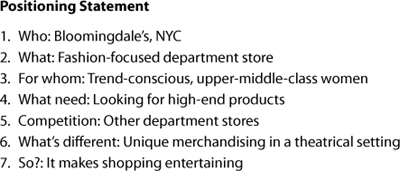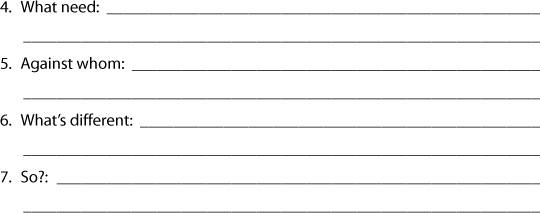5 Brand Development
Don’t flavor your brand plain vanilla. An effective brand has a likable or admired personality. It has added perfume. Likable ones could include McDonald’s, Budweiser, and Bloomingdale’s. Kids love McDonald’s with its premiums, especially the toys, and drag their parents with them. Bud is so likable it has the largest beer market share in the world. When women go into Bloomingdale’s in New York City they go star-crazy. Admired brands could include Apple, Cisco, Intel, and Neiman Marcus. If Steve Jobs ever wore a business suit, the company that makes those sexy products would lose its luster. Cisco and Intel are “out-chipping” their competitors. And who besides Neiman Marcus would have the gall to offer $250,000 Christmas presents?
Brands that could use some help might include Sears, Toyota, AT&T Internet service, and health insurers. Sears has really gone downhill in recent years. It doesn’t have a personality anymore. Toyota used to be flying high, but it now comes out that they knew of the problems with uncontrolled acceleration more than two years ago. If you want to keep your goodwill when you incur a problem, you want to tell the world as soon as possible, the way Johnson & Johnson did years ago when some bottles of Tylenol had been tampered with. I lost my Internet connection with AT&T and it took five hours and six technical support technicians to bring me back online. I need not make any comments about the health insurers.
You want to be unique, like the FedEx selling line, “When you absolutely, positively need it overnight,” although it appears that they have stupidly stopped using the phrase. I had a home builder client who had twenty-five homes he wanted to sell during the next twelve months with a relatively small advertising budget. I did some research and found that most other builders usually ran full-page newspaper ads, with a few scheduling a two-page spread. I proposed a three-page spread with the front page showing a couple drinking coffee and holding up an invitation card that read, “The Homes for Elegant Living.” When you turned the page, an illustration of the most attractive home was spread across the two pages, which was about twenty-two inches wide. At first the client thought I was nuts, because the ad would take up 90 percent of his entire budget. He finally agreed to let me run with it. I also had all salesmen wear white dinner jackets. The Sunday his ad ran, his subdivision was so mobbed I had to call the police to come out and handle the traffic. All of the homes were sold in ninety days—and we never had to run another ad.
You want to keep it simple. It is said that, after listening to a two-hour sermon, the First Lady asked her husband, President Coolidge, what the sermon was about. He replied, “Sin.” She was a little shocked, but then asked what the pastor said about it. The president is said to have replied, in his usual taciturn manner, “He was against it.” Years ago Hawaiian Punch ran a ten-second television commercial that made them number one in sales. It consisted of two cartoon characters in Hawaiian shirts, with one holding a bottle of the product. He asks the other if he would like a Hawaiian punch and when the man said yes, he leaned over and punched him in the nose.
There is a separate chapter on pricing in this book (Chapter 12, The Sales Plan: Pricing), but the main thing to remember is base your price on value, not on costs. DuPont developed a new resin for drainpipes that kept the pipe from leaking. The costs associated with using the resin were negligible, but DuPont increased the cost of the pipe 400 percent, because that was the value.
Base your development against the target audience, as discussed in Chapter 4, Customer Analysis, and don’t forget the 20/80 guideline: approximately 20 percent of the market should account for 80 percent of your profitable sales. And when you have a winning personality, stay with it. Rosser Reeves, when he was president of the advertising agency Ted Bates, was on his yacht with a client who reminded Bates that he had been running the same campaign for him for the last ten years and asked Reeves how many employees he had. Reeves answered, “Two thousand.” “Then,” asked the client, “what are they doing for me?” Reeves’s answer: “Those two thousand people are keeping your people from changing that campaign.”
So, what is your brand’s personality? If you are not sure, you should first obtain a statement of position, which details what your current and potential customers have to say about your company. You will probably need a benchmark research study (see Chapter 17, The Research Plan) to obtain the answers. After you complete this study, you can prepare your positioning statement.
Your positioning statement is your company’s personality. It is how you want to be perceived by your target audience. It is usually written by marketing people, but it should reflect your entire operation. Everything you do should be compatible with it. Following is a positioning statement that could have been written by Bloomingdale’s in New York City.
Figure 5–1 Possible positioning statement for Bloomingdale’s.

You may want to take a stab at writing your own now, but based on how you complete the remaining sections of this book, your initial draft may be altered. For example, in the next chapter you will determine what type of mousetrap you want your company to be and that will influence your positioning statement.
You can photocopy this worksheet or print out a copy of the positioning statement worksheet from your downloaded folder of Word worksheets.
Worksheet 5–1 Positioning statement

To execute your new or revised brand personality, you may have to increase your marketing budget and one of the best times to do so is when the economy is not doing so well. There have been many research studies that indicate that those companies that increase their marketing pressure during bad times are usually the ones that come out on top when the economy improves. And you may want to think beyond the current marketing tools you are using.
You do not have to be a large company to develop a favorable brand personality. A corporate jet refueler offers low fuel prices and fast service. It also has two women dressed in short white skirts and sleeveless T-shirts waving bright orange flags to direct pilots to its facility. But the real attraction for their customers is what’s in the brown paper bag the women slip to the pilots once they pulled in to fill up—Kansas City strip steaks. Pilots say their bosses like the fuel price, but they stop there for the steaks.

